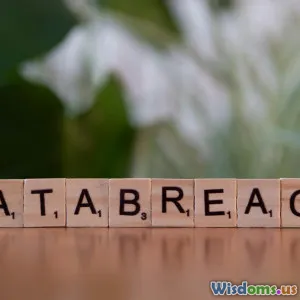
The Role of Blockchain in Cybersecurity
8 min read Explore how blockchain technology is reshaping cybersecurity by enhancing data integrity, decentralization, and trust in digital systems. (0 Reviews)
The Role of Blockchain in Cybersecurity
Cybersecurity has become a cornerstone of the digital era, safeguarding sensitive data, protecting personal privacy, and ensuring the integrity of online transactions. However, as cyber threats evolve in complexity and scale, traditional cybersecurity measures encounter significant challenges. Enter blockchain technology — a groundbreaking innovation originally designed for cryptocurrencies like Bitcoin — now making substantial inroads in enhancing cybersecurity. This article delves into the role of blockchain in cybersecurity, unraveling its advantages, challenges, and real-world applications.
Understanding Blockchain Technology
Before exploring its synergy with cybersecurity, it is vital to understand what blockchain entails. At its core, blockchain is a decentralized ledger system where information is recorded in secure blocks linked sequentially in a chain. Each block contains a set of transactions verified through consensus mechanisms like Proof of Work (PoW) or Proof of Stake (PoS).
Unlike traditional centralized systems, blockchain’s decentralized architecture ensures that no single entity controls the entire database. Transactions are transparent yet encrypted, traceable but pseudonymous, and immutable once written — attributes that naturally lend themselves to strong security frameworks.
Cybersecurity Challenges Today
Modern cybersecurity faces numerous critical concerns:
- Centralized Vulnerabilities: Central servers can become single points of failure — cybercriminals target them to trigger data breaches.
- Data Integrity Threats: Manipulation or tampering of data often goes undetected in systems lacking transparency.
- Identity Theft and Fraud: Current identity management frameworks are frequently compromised.
- Trust Deficit Among Stakeholders: In multi-party environments, establishing trust is complicated and costly.
Conventional cybersecurity tools such as firewalls, antivirus software, and intrusion detection systems primarily serve as defensive barriers. Still, they sometimes fall short against insider threats, advanced persistent threats (APTs), and sophisticated cyberattacks.
How Blockchain Revolutionizes Cybersecurity
1. Decentralization and Elimination of Single Points of Failure
A fundamental cybersecurity advantage of blockchain is decentralization. Unlike centralized databases prone to hacking and outages, blockchain’s distributed nodes collectively maintain the ledger. This architecture means that even if some nodes are compromised or go offline, the network remains functional and tamper-resistant.
Example: Ethereum’s decentralized network runs thousands of nodes worldwide, ensuring data and transaction availability even if some nodes experience attacks or fail.
2. Data Immutability and Integrity Assurance
Once data is recorded on the blockchain, altering it retroactively requires altering all subsequent blocks across most of the network's nodes — a prohibitively expensive, often practically impossible task. This immutability guarantees data integrity, essential for logs, audit trails, and compliance.
Real-World Insight: Healthcare organizations like IBM Watson Health utilize blockchain to maintain tamper-proof patient records. Data immutability not only improves patient safety but also addresses regulatory requirements such as HIPAA.
3. Enhanced Identity and Access Management (IAM)
Traditional IAM systems rely on usernames, passwords, and centralized verification authorities prone to breaches and credential stuffing attacks. Blockchain introduces decentralized identity systems (self-sovereign identity), enabling users to control and cryptographically prove their identity without relying on intermediaries.
Case Study: Microsoft’s decentralized identity initiative (ION) uses blockchain to empower users with greater control over their digital identities—significantly reducing the risk of identity theft.
4. Transparent and Secure Transaction Verification
Every transaction on a blockchain is transparent to authorized participants, fully traceable, and secured by cryptographic hashes. This transparency reduces fraud and unauthorized activities by making illicit behavior more easily detectable.
Example: Supply chain management platforms based on Hyperledger Fabric allow stakeholders to track product provenance transparently, minimizing counterfeit goods and data fraud.
5. Smart Contracts for Automated Security Policies
Smart contracts are self-executing code stored on blockchain that automatically enforce rules or agreements when predefined conditions are met. They can automate security policies such as access rights, transaction approvals, and incident responses.
Insight: Financial institutions use smart contracts to automate compliance checks—reducing manual errors and enabling real-time auditing, enhancing overall cybersecurity posture.
Current Limitations and Challenges
Like any cutting-edge technology, blockchain integration into cybersecurity is not without hurdles:
- Scalability: Transaction speed and network throughput are often slower compared to traditional databases.
- Regulatory Uncertainty: Compliance with data protection laws like GDPR presents challenges, especially concerning the "right to be forgotten."
- Integration Complexity: Merging blockchain with existing infrastructure demands specialized knowledge and resources.
- Energy Consumption: Some consensus algorithms (e.g., PoW) are resource-intensive, raising sustainability concerns.
Nonetheless, ongoing innovations, such as Layer 2 solutions, energy-efficient consensus protocols, and hybrid blockchain architectures, aim to mitigate these issues.
Practical Implementations in Cybersecurity
- Authentications Systems: Projects like Civic and uPort enable decentralized credentials, enhancing login security and privacy.
- Secure IoT Networks: IBM Blockchain’s initiatives help secure communication among IoT devices by preventing unauthorized data manipulation.
- Data Provenance and Audit Trails: Companies like Guardtime apply blockchain to verify logs and prevent tampering in critical infrastructure such as defense and finance.
Expert Opinions
As cybersecurity expert Bruce Schneier observed, "Blockchain won’t solve all security problems, but it provides a very powerful paradigm for ensuring data integrity and transparency." Similarly, Gartner predicted that by 2025, 30% of cybersecurity implementations will integrate blockchain properties to reduce fraud and improve identity management significantly.
Conclusion
Blockchain technology stands as a transformative tool combating the evolving landscape of cybersecurity threats. Its decentralized, immutable, and transparent architecture fundamentally addresses some of the weaknesses inherent in traditional security models. From enhancing data integrity to revolutionizing identity management, blockchain offers new paradigms for securing digital assets and fostering trust among stakeholders.
Although challenges such as scalability and regulation exist, the unparalleled advantages blockchain delivers compel businesses, governments, and technologists to explore and adopt it aggressively. Embracing blockchain in cybersecurity is not merely a trend but a strategic imperative for securing the digital future.
Whether you are a cybersecurity professional or a technology enthusiast, understanding blockchain’s role equips you with critical insight into shaping resilient, secure systems in a world increasingly defined by cyber risks.
By unlocking blockchain’s potential thoughtfully, we can architect an internet where trust is decentralized, data inviolable, and security intrinsic — a vision not just desirable but essential.
Rate the Post
User Reviews
Popular Posts





















